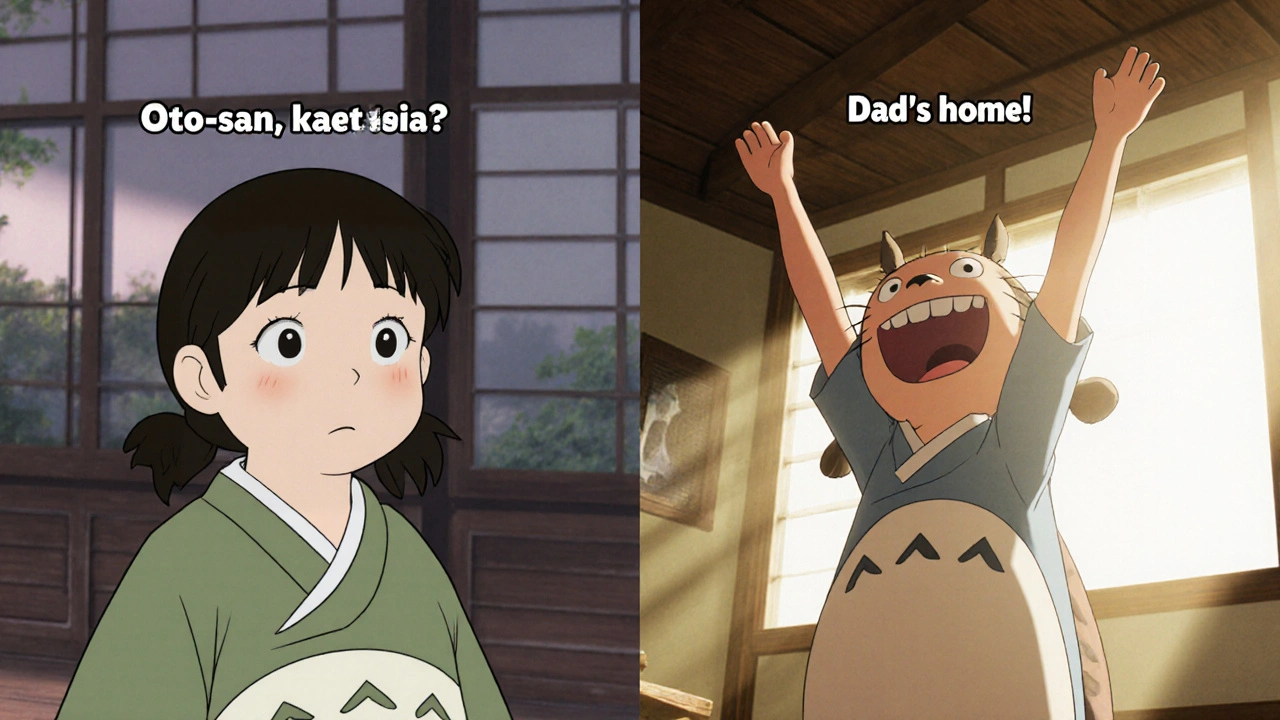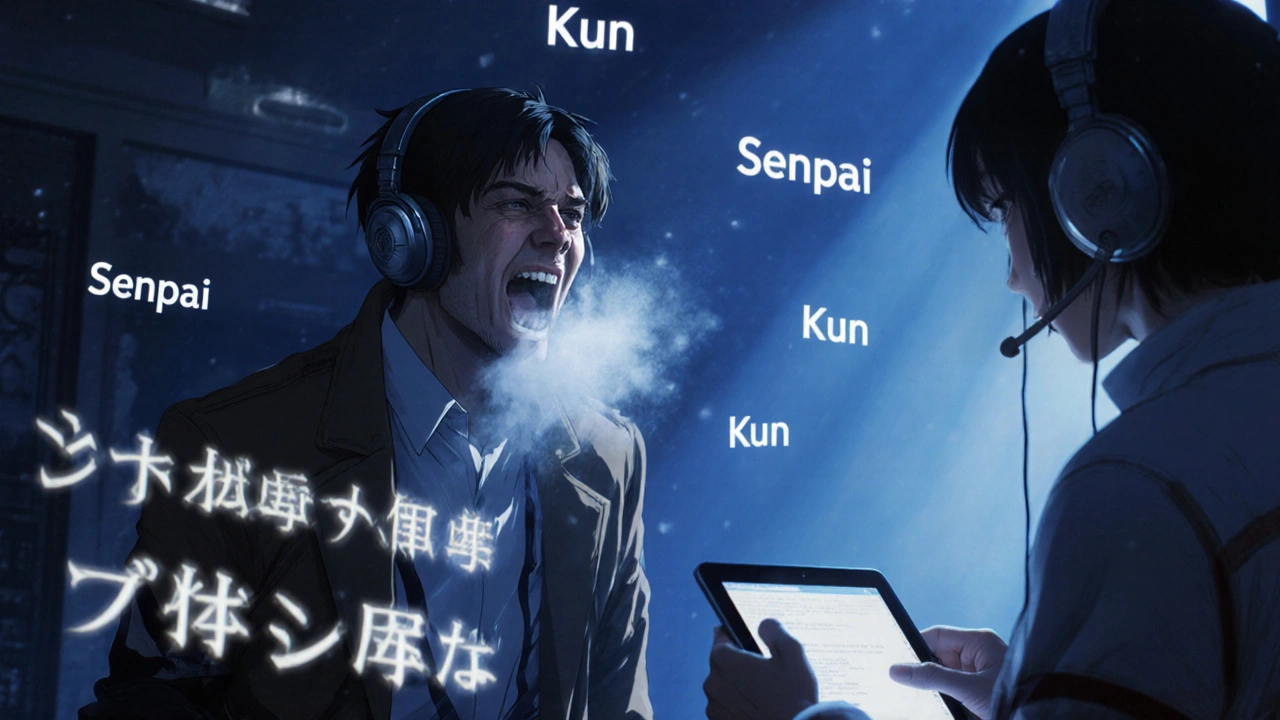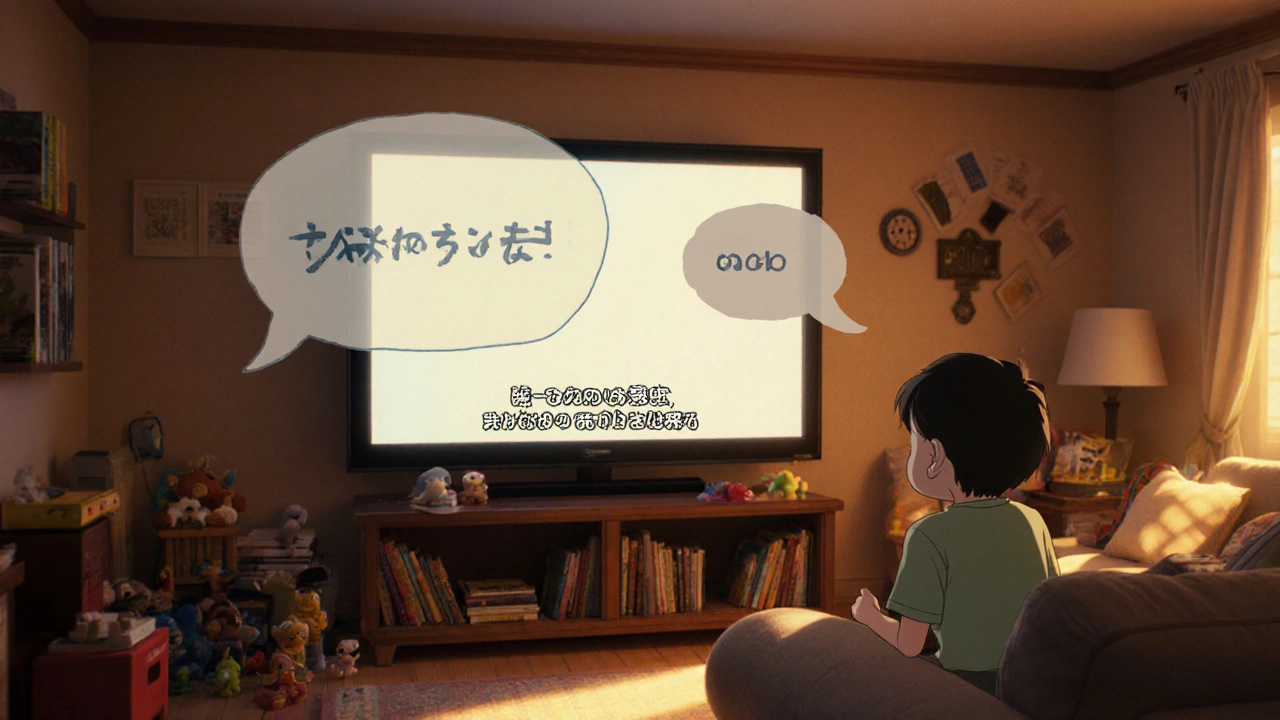When you watch anime, you’re not just watching a cartoon. You’re stepping into a world shaped by Japanese culture-humor that relies on wordplay, social hierarchies built into speech patterns, and references to festivals, food, and folklore that don’t exist elsewhere. And how that world reaches you-through subtitles or dubbing-changes everything. It’s not just about language. It’s about meaning, tone, emotion, and even identity.
What Happens When Words Don’t Translate Directly
Take a simple phrase like “I’m fine” in English. In Japanese, the equivalent-“大丈夫です” (daijōbu desu)-can mean anything from “I’m okay” to “Don’t worry about me” to “I’m hiding how much I’m hurting.” The context, the tone, the bow of the head-they all carry weight. A subtitle might just say “I’m fine.” A dub might change it to “I’ve got this” to match the character’s posture and facial expression. But which version feels more true?
One famous example is from My Neighbor Totoro. When Satsuki says “お父さん、帰ってきた?” (“Oto-san, kaette kita?”), a literal sub reads: “Dad, did you come back?” But the English dub says: “Dad’s home!” That’s not just a translation. It’s a cultural adjustment. The dub makes it feel like a child’s joyful announcement, which fits Western family dynamics better. The sub keeps it neutral, closer to how a Japanese child would speak. Neither is wrong. But they create different emotional experiences.
Why Subtitles Keep the Original Voice
Subtitles preserve the original audio-the actor’s breath, the pauses, the laughter, the way a voice cracks under stress. You hear the Japanese voice actors as they were directed. You hear the rhythm of the language. You notice how a character’s speech gets faster when they’re nervous, or slower when they’re grieving. That’s not just performance-it’s cultural expression.
Take Attack on Titan. The way Eren yells “Kimi wa mou, shinde iru!” (“You’re already dead!”) in the original has a raw, guttural edge. English dubs often smooth that out to sound more dramatic. But the original delivery is angry, desperate, and broken. Subtitles let you hear that. They force you to listen differently. You don’t just watch the scene-you decode it.
Subtitles also keep the original names, honorifics, and titles. “Senpai,” “Kun,” “San”-these aren’t just suffixes. They show power, age, respect. A dub might replace “Senpai” with “Upperclassman,” but that loses the intimacy, the unspoken hierarchy. In Japanese, calling someone “-san” instead of “-kun” can mean you’re keeping your distance. Subtitles keep those nuances alive.
Why Dubs Can Feel More Natural
But here’s the thing: not everyone wants to read while watching. And not every story works with subtitles. Some anime rely on fast-paced jokes, puns, or pop culture references that don’t land if you’re reading.
Take One Punch Man. The humor is absurd, rapid-fire, and built on Western-style comedy tropes. The original Japanese dub actually uses exaggerated, almost American-style voice acting. But the English dub? It doubles down. The voice actors don’t just translate-they recreate the joke. When Saitama says, “I’m not even trying,” the English version adds a deadpan sigh and a pause that makes it funnier than the original. That’s not lazy localization. That’s smart adaptation.
Good dubs don’t mimic. They reinterpret. A skilled dub director will recast lines to match lip movements, timing, and cultural context. In Death Note, Light Yagami’s cold, calculating tone in Japanese becomes even more chilling in English because the voice actor leans into the silence between words. The English version makes him feel more like a modern psychopath-less like a Japanese student, more like a global archetype.

The Hidden Cost of Bad Dubbing
Not all dubs are good. Some are rushed. Some are done by studios that treat anime like a cartoon, not a serious story. You’ve probably heard the ones where characters scream “Grrr!” or “Hah!” like they’re in a 90s video game. Or where “I hate you” becomes “I can’t stand you!” because the scriptwriter thought it sounded more “natural.”
These changes aren’t just annoying-they erase cultural texture. In Neon Genesis Evangelion, Shinji’s constant self-doubt is wrapped in hesitant speech patterns, pauses, and indirect language. A bad dub might turn him into a whiny teenager. But the original? He’s a traumatized boy who doesn’t know how to say what he feels. That’s not a performance flaw. That’s a cultural reflection of Japanese emotional restraint.
Bad dubs also change character relationships. In Clannad, the way Nagisa calls her father “Otōsan” isn’t just polite-it’s a sign of deep emotional distance. If the dub replaces it with “Dad,” you lose the tension. You no longer feel the gap between them. That’s not localization. That’s erasure.
What Fans Really Want-And Why It’s Complicated
Ask anime fans which they prefer, and you’ll get strong opinions. Sub purists say dubs “ruin the art.” Dub fans say subs “make you work too hard.” But the truth is, most people switch between them. They watch Demon Slayer in sub for the emotional scenes, then switch to dub for the action episodes. Or they watch My Hero Academia in dub because they grew up with English voice actors.
There’s also generational difference. Older fans who discovered anime in the 90s and 2000s often learned Japanese through subs. Newer fans, raised on Netflix and Crunchyroll, often prefer dubs because they’re more accessible. And studios know this. That’s why companies like Crunchyroll now release both versions simultaneously. They’re not just catering to fans-they’re building new ones.
Some dubs are even better than the original. The English dub of Fullmetal Alchemist: Brotherhood is widely considered superior to the Japanese version. Why? Because the voice actors understood the emotional core of each character. Edward’s rage, Al’s quiet sorrow, Roy’s dry humor-they didn’t just read lines. They lived them. And that’s what makes a dub unforgettable.

How Localization Decisions Are Made
Behind every subtitle and dub is a team of translators, directors, and voice coaches. They don’t just sit with a script and a dictionary. They watch the animation frame by frame. They time the lines to match mouth movements. They adjust jokes for cultural relevance. One translator told me they spent three weeks rewriting a single pun in Chainsaw Man because the original relied on a Japanese wordplay involving “blood” and “blessing”-two words that sound similar in Japanese but mean nothing together in English.
They also make hard choices. Should they keep “kami-sama” as “god” or change it to “the divine”? Should they translate “hentai” as “pervert” or leave it as “hentai” (which now means something very different in the West)? These aren’t linguistic decisions. They’re cultural ones.
And sometimes, they change names. In Dragon Ball, “Kuririn” became “Krillin.” “Goku” stayed the same. “Piccolo” was kept because it sounded cool. But “Tien Shinhan” became “Tien” because “Shinhan” meant nothing to Western audiences. That’s not laziness. That’s strategy.
Which Should You Choose?
There’s no right answer. But here’s how to decide:
- Watch in subtitles if you care about authenticity, emotional nuance, and original voice acting. You’ll notice the silence, the breaths, the subtle shifts in tone.
- Watch in dub if you want immersion, faster pacing, and a story that feels like it was made for you. A good dub doesn’t feel like a translation-it feels like the original.
- Try both. Watch the same episode in both versions. Notice how the same line can make you feel differently.
- Don’t judge dubs by the bad ones. The English dub of Monster is haunting. The dub of Parasyte is terrifying. The dub of Monster is haunting. The dub of Parasyte is terrifying. The dub of Haikyuu!! is full of energy. These aren’t exceptions-they’re proof that dubs can be art.
At the end of the day, anime isn’t just about what’s said. It’s about how it’s felt. Subtitles give you the words. Dubs give you the feeling. Both are valid. Both are necessary. The best fans don’t pick one side. They learn to appreciate both.
Are subtitles always more accurate than dubs?
Not always. Subtitles translate the words, but not always the intent. A good dub adapts the meaning to fit cultural context, timing, and emotion. Sometimes, a dub captures the spirit of a scene better than a literal translation ever could.
Why do some anime dubs sound cheesy?
Many early dubs were made quickly and cheaply, with voice actors who didn’t understand the material. Some studios treated anime like kids’ cartoons. Today, better studios like Crunchyroll and Funimation hire professional actors and directors who treat anime as serious drama. The bad dubs still exist, but they’re no longer the norm.
Can you learn Japanese from anime subtitles?
Yes, but with limits. Subtitles help you recognize common phrases, honorifics, and sentence structures. But anime dialogue is often informal, exaggerated, or stylized. It’s not a replacement for formal study-but it’s a great way to build familiarity and ear training.
Do Japanese fans watch anime in English dub?
Rarely. Most Japanese fans watch anime in its original language. But some do enjoy English dubs out of curiosity, especially if they’re learning English. There’s even a small fanbase that prefers the English dub of Neon Genesis Evangelion because of its dramatic tone.
Why do some anime have multiple dubs?
Different studios license the same anime for different regions. One studio might make a North American dub, another a UK dub. Sometimes, the UK version uses British accents and slang, which changes the feel. For example, the UK dub of My Hero Academia uses British expressions like “brilliant” instead of “awesome,” which changes the tone slightly.

